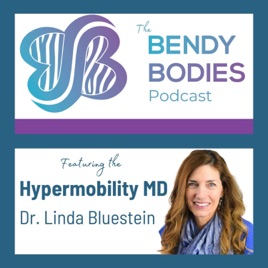
Advertise on podcast: Bendy Bodies with the Hypermobility MD, Dr. Linda Bluestein
Rating
4.9 from
Country
This podcast has
91 episodes
Language
Publisher
Explicit
No
Date created
2020/02/26
Average duration
70 min.
Release period
8 days
Description
Connective tissue disorders, like Ehlers-Danlos Syndromes (EDS), have far-reaching consequences. Multi-systemic symptoms affect quality of life -- with pain, frequent injury, joints “giving way," fatigue, headache, gastrointestinal problems, and insomnia being common. Welcome to Bendy Bodies with the Hypermobility MD, with your host and founder, Linda Bluestein, MD. Learn from specialists with diverse areas of medical and scientific expertise. Conversations cover topics relevant to everyone with symptomatic joint hypermobility (EDS, HSD, Marfan's). Learn to optimize your hypermobile health!
Social media
Check Bendy Bodies with the Hypermobility MD, Dr. Linda Bluestein social media presence
Podcast episodes
Check latest episodes from Bendy Bodies with the Hypermobility MD, Dr. Linda Bluestein podcast
91. Hand Problems in EDS with Corinne McLees, OT and Hand Coach
2024/02/22
In this episode, Dr. Linda Bluestein and Corinne McLees discuss hand problems in EDS including pain, weakness, and injuries. This conversation covers various topics related to hand problems, including ring splints, hand exercises, avoiding strain and hyperextension, tips for traveling, challenges of the medical system for chronic pain, hand pain with writing, hand pain and numbness in sleep, thumb pain and De Quervain's tendonitis, cubital tunnel syndrome, TFCC tear, trigger finger and so much more.
Takeaways
Hand pain, weakness, and injuries are common in individuals with joint hypermobility.Hand pain in connective tissue disorders can be caused by hypermobility, subluxations, nerve impingement, and arthritis.TheraPutty is a useful tool for strengthening hands. Low profile hand support options include kinesio tape, silicone thumb supports, and the Push MetaGrip.Traditional therapies may not work for hand pain in hypermobility if the underlying hypermobility is not addressed.Ring splints can provide support and stability for hypermobile joints in the hands.Insurance coverage for ring splints may vary, and Silver Ring Splints is a US-based provider that offers insurance coverage options. Trigger finger occurs when the tissue surrounding a tendon becomes knotted, causing the tendon to catch and lock when the finger is flexed.Steroid injections combined with splinting can be effective in treating trigger finger, especially in acute cases.Trigger finger may be misdiagnosed in the hypermobile population, as it can be a result of subluxation rather than tissue accumulation.Hypermobility hacks include ergonomic hand movements, swimming, abdominal compression, and prioritizing daily movement.
YOUR host, as always, is Dr. Linda Bluestein, the Hypermobility MD.
Chapters
00:00 Introduction and Overview
01:38 Difference between Occupational and Physical Therapy
04:44 Common Reasons for Hand Pain in Connective Tissue Disorders
09:53 Approach to Hypermobility in Hands
12:46 Strengthening Hands with TheraPutty
20:55 Strengthening Hands without Overdoing It
21:27 Reasons Traditional Therapies May Not Work for Hand Pain
24:08 Low Profile Hand Support Options
28:23 Ring Splints and Insurance Coverage
38:34 Ring Splints and Plastic Splints
40:33 Hand Exercises for Different Age Groups
42:33 Avoiding Strain and Hyperextension
45:21 Tips for Traveling with Hand Problems
47:51 Challenges of the Medical System for Chronic Pain
51:22 Hand Pain with Writing
53:52 Hand Pain and Numbness in Sleep
56:16 Thumb Pain and De Quervain's Tendonitis
59:17 Cubital Tunnel Syndrome
01:02:19 Torn Triangular Fibrocartilage Complex (TFCC)
01:06:14 Decuervain's Tendonitis
01:09:17 TFCC Tear
01:13:32 Trigger Finger
01:17:31 Differentiating Trigger Finger from Subluxation
01:18:38 Pulley Injuries in Rock Climbers
01:19:25 Hypermobility Misdiagnosis
01:20:46 Hypermobility Hacks
Connect with YOUR Bendy Specialist, Dr. Linda Bluestein, MD at https://www.hypermobilitymd.com/.
Thank YOU so much for tuning in. We hope you found this episode informative, inspiring, useful, validating, and enjoyable. Join us on the next episode for YOUR time to level up your knowledge about hypermobility disorders and the people who have them.
Join YOUR Bendy Bodies community at https://www.bendybodiespodcast.com/.
YOUR bendy body is our highest priority! 🧬🔬🦓
Resources:
Learn more about guest, Corinne McLees here:
https://www.handcoachcorinne.com/
Check out the items mentioned in episode 91 here:
https://amzn.to/49FkaGY
Check out the Bendy Bodies Amazon Shop here:
https://www.amazon.com/shop/hypermobilitymd
Links to other products:
https://www.silverringsplint.com/
https://www.evabellejewelry.com/
https://bracelab.com/metagrip.html?utm_source=Affiliate+Partnership&utm_medium=Social&utm_campaign=Corinne
#HandPain #HandProblems #HandWeakness #WristPain
#BendyBodiesPodcast #BendyBuddy #HypermobilityMD
more
90. Decoding Brain Fog: Expert Insights with Ilene Ruhoy, MD, PhD
2024/02/15
In this episode, Dr. Linda Bluestein interviews Dr. Ilene Ruhoy about causes of brain fog, as well as its relationship to various conditions such as mast cell activation syndrome, craniocervical instability, dysautonomia, and CSF leaks. She explains how these conditions contribute to cognitive dysfunction and the importance of identifying underlying causes. Dr. Ruhoy emphasizes the need for a comprehensive evaluation and individualized treatment approach for patients experiencing brain fog. They delve into the role of nutrition in cognitive function, emphasizing the impact of food choices on inflammation. They highlight the importance of avoiding processed foods and sugar, increasing vegetable consumption, and improving lifestyle factors. Dr. Ruhoy shares surprising findings on the MRI of mast cell activation syndrome (MCAS) patients.
YOUR host, as always, is Dr. Linda Bluestein, the Hypermobility MD.
Takeaways
Brain fog is characterized by cognitive difficulties such as slow thinking, difficulty learning and recalling information, and trouble focusing and paying attention.Conditions such as mast cell activation syndrome (MCAS), craniocervical instability (CCI), dysautonomia, Ehlers-Danlos Syndromes, and CSF leaks can contribute to cognitive dysfunction and brain fog.Intracranial hypertension (high pressure), hypotension (low pressure), and Tarlov cysts can also contribute to brain fog. Identifying the underlying causes of brain fog is crucial for developing an effective treatment plan.A comprehensive evaluation, including medical history, imaging studies, and laboratory tests, can help determine the contributing factors and guide treatment decisions. Applying knowledge gained from podcasts and research in clinical practice can help healthcare professionals provide better care to their patients.Making a meaningful difference in patients' lives is a rewarding aspect of being a healthcare professional.Nutrition plays a crucial role in cognitive function, and food choices can either be anti-inflammatory or pro-inflammatory.Avoiding processed foods and sugar, increasing vegetable consumption, and improving lifestyle factors can positively impact cognitive function.
Chapters
00:00 Introduction of Dr. Ilene Ruhoy
01:57 Defining Brain Fog
04:14 Risk Factors for Brain Fog
09:42 Identifying Contributing Factors
11:52 Cognitive Dysfunction and Mast Cell Activation Syndrome
14:09 Cognitive Dysfunction and Craniocervical Instability
18:18 Cognitive Dysfunction and CSF Leak
22:59 Cognitive Dysfunction and Dysautonomia
25:25 Cognitive Dysfunction and Upper Cervical Instability
30:12 Cognitive Dysfunction and CSF Leak
38:11 Applying Knowledge in Clinical Practice
39:04 The Importance of Making a Meaningful Difference
40:31 The Role of Nutrition in Cognitive Function
42:38 The Impact of Food Choices on Inflammation
43:44 Avoiding Processed Foods and Sugar
44:38 The Role of Complex Carbohydrates and Dairy
45:28 Increasing Vegetable Consumption
46:44 Improving Lifestyle Factors
47:09 Where to Find Dr. Ilene Ruhoy Online
Connect with YOUR Bendy Specialist, Dr. Linda Bluestein, MD at https://www.hypermobilitymd.com/.
Thank YOU so much for tuning in. We hope you found this episode informative, inspiring, useful, validating, and enjoyable. Join us on the next episode for YOUR time to level up your knowledge about hypermobility disorders and the people who have them.
Join YOUR Bendy Bodies community at https://www.bendybodiespodcast.com/.
YOUR bendy body is our highest priority! 🧬🔬🦓
Resources:
https://www.bendybodiespodcast.com/13-healing-the-brain-holistically-with-ilene-ruhoy-md-phd/
https://patreon.com/unraveledpod
https://instagram.com/ileneruhoymdphd/
https://twitter.com/RuhoyMD
https://tiktok.com/ileneruhoymdphd
#BrainFog #BrainFogAwareness #BrainHealth
#FunctionalMedicine #NutritionForBrainHealth #InflammationAwareness
#MastCellActivationSyndrome #MCAS #CSFLeakInsights #TarlovCystAwareness
more
89. Conquering the Sleep Struggle with Roger Seheult, MD
2024/02/08
In this episode, Dr. Linda Bluestein interviews Dr. Roger Seheult about the importance of sleep for people with chronic illness, chronic pain, and joint hypermobility. Dr Seheult, a quadruple board-certified physician with expertise in sleep medicine, discusses various topics related to sleep, including the circadian rhythm, the impact of light on sleep, the effect of blue light on sleep, ideal bedtime, the impact of electronics on sleep, the role of melatonin, and the timing of eating and its effect on sleep. Other topics include challenges of working from home, sleep schedules and chronic illness, shifting sleep patterns, sleep apnea and its relationship with chronic illness, sleep medications, sleep watches and monitoring devices, sleep positions and joint instability, and the importance of sleep education in medical training. Dr. Seheult provides valuable insights and recommendations for improving sleep quality and managing sleep-related issues.
YOUR host, as always, is Dr. Linda Bluestein, the Hypermobility MD.
Takeaways:
Sleep is crucial for people with chronic illness, chronic pain, and joint hypermobility.
Understanding the circadian rhythm is important for optimizing sleep.
Light, especially blue light, can significantly impact sleep quality.
The suprachiasmatic nucleus plays a key role in regulating the sleep-wake cycle.
Morning light exposure is important for setting the body's internal clock.
The timing of eating can affect sleep quality.
Establishing a consistent sleep schedule and avoiding late-night eating can improve sleep quality.
Shifting sleep patterns can be challenging, especially for individuals with chronic illness.
Sleep apnea is common in individuals with chronic illness and connective tissue disorders like Ehlers-Danlos Syndromes.
Home sleep studies can be effective in detecting sleep apnea, but in-lab studies may be necessary for individuals at higher risk of central apnea.
Sleep medications should be used cautiously due to potential side effects and dependency issues.
Sleep watches and monitoring devices can provide valuable insights into sleep patterns and quality.
Proper sleep positions, pillows, and mattresses can help alleviate joint instability and pain during sleep.
Education on sleep disorders and their relationship with chronic illness should be improved in medical training.
Patient advocacy and sharing information through podcasts can help raise awareness and improve access to sleep education.
Chapters
00:00 Introduction of Dr. Roger Seheult
03:22 Understanding the Circadian Rhythm
07:02 Impact of Light on Sleep
09:20 The Suprachiasmatic Nucleus and its Role in Sleep
09:49 The Importance of Light for People with Chronic Illness
13:35 The Effect of Blue Light on Sleep
15:28 Ideal Bedtime for Optimal Sleep
17:25 The Impact of Electronics on Sleep
19:26 The Role of Melatonin in Sleep
20:05 The Importance of Morning Light
23:29 The Timing of Eating and its Effect on Sleep
24:00 Challenges of Working from Home and Small Meals
25:20 Sleep Schedule and Chronic Illness
28:57 Falling Asleep While Watching TV
31:49 Sleep Apnea and Chronic Illness
39:05 Sleep Apnea and Temporomandibular Dysfunction
44:09 EDS and Central Sleep Apnea
44:30 Elevating the Head of the Bed
45:23 Alignment Problems and Breathing
47:37 Sleep Medications and Side Effects
1:00:15 Supplements for Sleep
1:02:01 Sleep Watches and Monitoring Devices
1:03:01 Sleep Positions and Joint Instability
1:04:46 Paresthesias and Numbness in Sleep
1:05:11 Pillow Recommendations for Cervical Instability
1:07:35 Waking Up in Pain
1:09:58 Sympathetic Nervous System Activation
1:12:23 Safety of Melatonin
1:14:49 Improving Education on EDS and HSD
Connect with YOUR Bendy Specialist, Dr. Linda Bluestein, MD at https://www.hypermobilitymd.com/.
Thank YOU so much for tuning in. We hope you found this episode informative, inspiring, useful, validating, and enjoyable. Join us on the next episode for YOUR time to level up your knowled
more
88. Service Dogs and Disability Rights with Tiffany Lee, JD
2024/02/01
In this episode, Professor Tiffany Lee is interviewed about service dogs and disability rights and accommodations. They discuss the Americans with Disabilities Act, the definition of disability, and disability benefits. They also explore reasonable accommodations in the workplace and education settings, as well as the challenges and advocacy involved. The conversation covers topics such as disclosing disabilities to employers and universities, getting a service dog, dealing with unresponsive disability lawyers, appealing denied disability benefits, and correcting inaccuracies in medical records. The episode provides valuable insights and guidance for individuals with disabilities navigating legal and practical aspects of their rights and accommodations. Professor Lee wanted to clarify the following points from the discussion of Social Security disability. SSI places limits on assets ($2000 for an individual) and income. SSDI does not have an asset limit but requires the recipient not be able to engage in “substantial gainful activity,” which generally acts as an income limit. There is a “Ticket to Work” program called “Choose Work” available that provides some options similar to those in the earlier “Ticket to Work” program mentioned in this episode.
YOUR host, as always, is Dr. Linda Bluestein, the Hypermobility MD.
Key points discussed:
**Americans with Disabilities Act (ADA):** The conversation explores the ADA, a crucial piece of legislation that prohibits discrimination against individuals with disabilities and mandates reasonable accommodations.
**Disability Benefits:** The episode delves into disability benefits, including the process of applying, appealing denied benefits, and addressing inaccuracies in medical records.
**Workplace and Education Accommodations:** Reasonable accommodations in both workplace and education settings are explored, shedding light on the challenges and advocacy involved.
**Disclosure to Employers and Universities:** Professor Tiffany Lee provides insights into the considerations and potential challenges of disclosing disabilities to employers and universities.
**Service Dogs:** The episode discusses obtaining a service dog and the associated considerations.
**Dealing with Disability Lawyers:** Challenges related to unresponsive disability lawyers are addressed, offering guidance on how to navigate such situations.
**Financial Impact of Disability:** The limitations and financial impact of applying for disability, including asset limits and restrictions on work and income, are discussed.
**Flaws in the Disability System:** Issues within the disability system, such as the poverty threshold and its impact on marriage, are highlighted.
**Emergency Response Accessibility:** Making disaster and emergency response accessible to people with disabilities is discussed.
Overall, the episode provides an exploration of the legal, practical, and personal aspects of disability rights and accommodations, offering valuable insights and guidance for individuals with disabilities.
Chapters
00:00 Introduction and Overview
01:14 Americans with Disabilities Act
03:28 Reasonable Accommodations in the Workplace
04:38 Determining Reasonable Accommodations
09:07 Accommodations in High School and College
11:22 Challenges with Disability Services in Education
13:59 Advocating for Accommodations in Education
16:36 Disclosing Disabilities to Employers and Universities
19:03 Determining Job Compatibility with Accommodations
21:03 Getting a Service Dog
23:37 Regulations and Considerations for Service Dog Training
36:33 Dealing with Unresponsive Disability Lawyers
38:07 Appealing Denied Disability Benefits
40:03 Legal Recourse for Undertreatment of Pain
43:07 Accommodations for Productivity Standards
43:45 Correcting Inaccuracies in Medical Records
47:46 Knowing When to Get an Accommodation or Apply for Disability
48:36 Considerations for Applying for Disability
50:23 Assets and Poverty Thr
more
87. Disordered Eating in Dance with Josh Spell, LICSW, and Guest Co-Host Jennifer Milner
2024/01/25
In this episode, psychologist Josh Spell discusses disordered eating in dance. Josh shares insights into the coping mechanisms behind eating disorders and offers advice for directors, teachers, and friends who suspect someone may be struggling with an eating disorder.
YOUR host, as always, is Dr. Linda Bluestein, the Hypermobility MD.
YOUR guest co-host is Jennifer Milner, former professional ballet and Broadway dancer and founder of Bodies In:Motion.
Takeaways
Dancers, especially those with hypermobility, are at a higher risk for developing eating disorders due to the pressure to achieve a certain body image and the overlap with other mental health issues.Eating disorders are often coping mechanisms that provide a sense of control or avoidance of difficult emotions and stressors.The dance world's emphasis on perfectionism and sacrifice can contribute to the development of eating disorders.It is important for dance studios and companies to have protocols in place for addressing eating disorders and to provide support and resources for dancers.If you suspect someone may be struggling with an eating disorder, reach out to a trusted adult or professional for guidance and support.
Chapters
00:00 Introduction and Welcome
00:30 Introducing Josh Spell
01:36 Prevalence of Eating Disorders in Dancers
03:09 The Relationship Between Hypermobility and Eating Disorders
05:08 Understanding Eating Disorders as Coping Mechanisms
08:00 The Intersection of Eating Disorders and Other Mental Health Issues
10:35 The Impact of Social Media and Diet Culture on Eating Disorders
13:25 Self-Image and Body Standards in the Dance World
16:19 The Influence of Social Media and Zoom on Body Image
20:25 Balancing Sacrifice and Suffering in the Dance World
23:00 The Role of Dance Studios and Companies in Supporting Dancers' Mental Health
27:13 Steps for Directors and Teachers to Take When Suspecting an Eating Disorder
32:47 Steps for Friends and Loved Ones to Take When Suspecting an Eating Disorder
36:31 Steps to Take If You Suspect You Have an Eating Disorder
42:18 Hypermobility Hack: Giving the Eating Disorder a Persona
45:12 Where to Find Josh Spell Online
This important conversation with Josh Spell about disordered eating in dance will leave you feeling more knowledgeable and better equipped to handle difficult situations.
Connect with YOUR Bendy Specialist, Dr. Linda Bluestein, MD at https://www.hypermobilitymd.com/.
Thank YOU so much for tuning in. We hope you found this episode informative, inspiring, useful, validating, and enjoyable. Join us on the next episode for YOUR time to level up your knowledge about hypermobility disorders and the people who have them.
Join YOUR Bendy Bodies community at https://www.bendybodiespodcast.com/.
YOUR bendy body is our highest priority! 🧬🔬🦓
Resources mentioned during the episode:
Links for show notes:
https://flexiblemindcounseling.org/
https://www.instagram.com/spellbound20/
https://www.linkedin.com/in/josh-spell-msw-licsw-07b17816/
https://www.jennifer-milner.com/
National Suicide Prevention Lifeline: 1.800.273.8255
Crisis Text Line: Text HOME to 741741; Free crisis support, anywhere in US
Eating Disorder Helpline: Call or text 1.800.931.2237
NEDA – National Eating Disorders Association: www.nationaleatingdisorders.org
NAMI – National Alliance on Mental Illness: www.nami.org
Project Heal – https://www.theprojectheal.org/
Find an Accredited Registered Dietitian (RDN) – www.eatright.org/find-an-expert
Find a Therapist: www.psychologytoday.com/us/therapists
#Hypermobility #JointHypermobility #BalletLife #HypermobilityAware #DanceWellness #BodyPositiveBallet #HealthyDancer #BalletBodyLove #DancerTips #NutritionForDancers #EmpoweredDancer #NourishYourPassion #MindBodyBallet #BalancedDancerLife #hEDS #EhlersDanlos #HSD
more
86. The Unfair EDS Journey with Amanda Cassil, PhD
2024/01/18
In this episode, psychologist Dr. Amanda Cassil discusses the unfair EDS journey (Ehlers-Danlos Syndromes) and provides strategies for effectively communicating with healthcare providers. Dr. Cassil provides valuable insights and tools for navigating the healthcare system and improving the quality of life for individuals with chronic illnesses. In this conversation, Dr. Amanda Cassil and Linda Bluestein, MD discuss the challenges faced by patients with hypermobility disorders (like Ehlers-Danlos Syndromes) and chronic illnesses.
YOUR host, as always, is Dr. Linda Bluestein, the Hypermobility MD.
Takeaways
Approach advocacy from a place of compassion and understandingRegulate your nervous system and slow down to make more intentional and strategic decisionsAcknowledge and process grief as a natural part of living with chronic illnessConsult with trusted individuals and healthcare providers for guidance and support.Collaboration between patients and healthcare providers can be challenging due to the merging of different knowledge and experiences.Patients can advocate for themselves by asking doctors how to prioritize and address multiple symptoms and issues.Dialectical behavioral therapy (DBT) is an effective tool for nervous system and emotional regulation.Patients should remember that their medical journey is often unfair, but there are healthcare providers working to make systemic changes.
Chapters
00:00 Introduction
01:04 Motivation for Giving the Talk at the EDS Society Global Conference
04:14 Advocacy and the Challenges of the Healthcare System
07:16 Approaching Advocacy without Blame
10:27 Grief and Acceptance in Chronic Illness
13:34 Key Takeaways from the Talk
18:04 The Role of the Prefrontal Cortex in Chronic Illness
19:12 Neurodiversity and Advocacy
20:12 Presenting Research to Doctors
23:02 Dealing with Suboptimal Experiences with Clinicians
26:09 Processing Traumatic Experiences
29:16 The Role of Grief in Chronic Illness
36:09 Coping with Traumatic Experiences
40:36 Presenting Research to Doctors (Continued)
46:27 Navigating the Challenges of Collaboration
48:07 Addressing Multiple Symptoms and Issues
53:42 Dialectical Behavioral Therapy (DBT) for Nervous System and Emotional Regulation
59:41 Finding Your Way Through an Unfair Journey
This important conversation with Dr. Amanda Cassil about the unfair EDS journey will leave you feeling better equipped to handle difficult medical encounters.
Connect with YOUR Bendy Specialist, Dr. Linda Bluestein, MD at https://www.hypermobilitymd.com/.
Thank YOU so much for tuning in. We hope you found this episode informative, inspiring, useful, validating, and enjoyable. Join us on the next episode for YOUR time to level up your knowledge about hypermobility disorders and the people who have them.
Join YOUR Bendy Bodies community at https://www.bendybodiespodcast.com/.
YOUR bendy body is our highest priority!
Resources mentioned during the episode:
https://www.STEMpsychology.com
https://www.instagram.com/stempsychology/
https://www.linkedin.com/in/drcassil
https://drgabormate.com/book/the-myth-of-normal/
https://www.resmaa.com/merch
https://www.besselvanderkolk.com/
#HealthJourney #ChronicIllness #ChronicPain #EhlersDanlos #HSD #JointHypermobility #HypermobileLife #MedicalGaslighting
#BendyBuddy #HypermobilityMD #BendyBodies #HealthAdvocacy #SupportPatients #PatientEmpowerment #HealthcareStruggles #WomenInStem #DisabledInStem
more
85. Making a MCAS Documentary with Drs. Weinstock, Dempsey, Bluestein, Afrin, Kinsella & Jill Brook, MA
2024/01/11
In this Bendy Bodies with the Hypermobility MD podcast episode, making a MCAS documentary is discussed. Distinguished participants in this collaborative effort include Dr. Leonard Weinstock, Dr. Larry Afrin, Dr. Tania Dempsey, Dr. Laurence Kinsella, and Dr. Linda Bluestein, alongside dedicated patient advocate Jill Brook.
YOUR host, as always, is Dr. Linda Bluestein, the Hypermobility MD.
Key Highlights:
1. The initiative incorporates both a documentary and an online educational library strategically designed to elevate awareness surrounding MCAS, Dysautonomia, and Hypermobility Spectrum Disorders.
2. Renowned healthcare professionals, namely Dr. Leonard Weinstock, Dr. Larry Afrin, Dr. Tania Dempsey, Dr. Laurence Kinsella, and Dr. Linda Bluestein, in conjunction with patient advocate Jill Brook, are pivotal contributors to this initiative.
3. The documentary aspires to elucidate the myriad challenges confronted by individuals navigating the complexities inherent in the triad of syndromes, emphasizing the imperative of heightened awareness among healthcare providers to facilitate more efficacious treatment modalities.
4. Dr. Afrin underscores the prevalence of MCAS and advocates for its consideration in the differential diagnosis for patients with complex medical presentations.
5. The term "dystrophism" is introduced within the discourse, signifying aberrations in growth and development propelled by dysfunctional mast cells.
6. Participants candidly share their experiences during the documentary's filming process, underscoring the inherent difficulty of condensing intricate information into concise soundbites.
7. The timely recognition of MCAS is underscored as a critical determinant for effective treatment interventions and an enhanced quality of life.
8. The team is dedicated to elucidating the nuances of MCAS, POTS, and EDS through the medium of a documentary, with the aim of providing comprehensive knowledge about these medical conditions.
9. Emphasis is placed on the significance of joint hypermobility. Should it give rise to complications, it may serve as a potential indicator for dysautonomia or MCAS.
10. Dysautonomia serves as an encompassing term, inclusive of conditions such as POTS and Inappropriate Sinus Tachycardia.
11. Identifying growing pains (quite literally!) associated with these conditions can be a challenging endeavor. The gradual development poses a considerable challenge for all involved.
12. A fervent commitment is made towards establishing an educational repository, replete with in-depth explorations by experts, delving into the intricacies of these subjects.
13. The team candidly discloses the necessity for financial support to conclude their documentary project. Their overarching objective is to disseminate awareness about MCAS, POTS, and EDS.
14. The documentary, at its core, is designed to render this information easily accessible, ensuring that individuals – be they patients, families, or clinicians – can acquire a comprehensive understanding of coping with these conditions.
Chapters
00:00 Introduction00:37 Creating Awareness and Increasing Treatment Options03:09 The Birth of the Documentary Project05:20 Filming in New York07:19 Filming in St. Louis10:32 The Motivation to Work with Complex Patients15:49 The Journey of Recognizing MCAS17:34 The Impact of MCAS Treatment21:00 Personal Experiences and Incorporating MCAS Treatment22:42 The Need for an Educational Library25:29 The Challenge of Condensing Information26:21 Describing MCAS in Sound Bites31:10 The Importance of Raising Awareness34:42 Growth and Development Abnormalities in MCAS40:03 Main Points about Hypermobility Syndromes and Dysautonomia44:48 Partnership with LDN Research Trust51:47 Final Words and Call for Support54:26 Recognition and Treatment of Unrecognized Patients55:44 Importance of Learning and Trying56:13 Gratitude for Dedicated Doctors56:47 Closing Remarks and Resources
Connect with YOUR Bendy Specialist, Linda Bl
more
84. Slipping Rib Surgery in EDS with Adam Hansen, MD
2024/01/04
In this episode, join thoracic surgeon and chest wall reconstruction expert Adam Hansen, MD, to learn about slipping rib surgery in EDS. Well known for his innovative surgeries for slipping rib syndrome (SRS), Dr Hansen has treated close to 1000 SRS patients. Many of his patients are challenged with Ehlers-Danlos Syndrome and other skeletal hypermobility disorders.
YOUR host, as always, is Dr. Linda Bluestein, the Hypermobility MD.
Takeaways
Slipping rib syndrome and other chest wall disorders are often related to skeletal hypermobility.Evaluation and diagnosis of chest wall problems require a thorough physical exam and imaging, such as CT scans.Symptoms of chest wall compression syndromes include pain, breathing difficulties, and organ dysfunction.Emerging areas of discovery include posterior joint disorders and bridging cartilage separation.Self-help strategies, such as improving posture and specific exercises, can help manage chest wall problems and potentially avoid surgery. Maintaining good posture and performing exercises that strengthen the back can help alleviate slipping rib syndrome.Taping strategies and lifestyle changes, such as using lumbar pillows and sit-to-stand desks, can provide relief and improve posture.Avoid high velocity manipulation, as it can exacerbate slipping rib syndrome.Candidates for surgery should have a strong core, realistic expectations, and should reduce or eliminate the use of pain medications before the procedure.The Hansen 3.0 technique is the preferred surgical procedure for slipping rib syndrome, offering better outcomes compared to previous techniques.The surgery has a low rate of complications, with the most common being collapsed lungs, hematomas, and wound infections.There is no significant difference in outcomes between patients with hypermobility spectrum disorder and those with Ehlers-Danlos syndrome.The likelihood of recurrence or additional slipped ribs after repair is low when the surgery is performed correctly.Physicians should be aware of slipping rib syndrome and other chest wall problems and stay updated on the latest techniques and treatments. Dr. Adam Hansen teaches other surgeons how to address slipping ribs and complex chest wall reconstruction.He has built a network of surgeons around the world to provide local treatment options for patients.There is a correlation between cervical instability and slipping ribs, and both are part of the broader issue of hypermobility and skeletal disorders.Focusing on key areas for stability, such as the core, can have a significant impact on overall care and muscle strength.Chapters
00:00 Introduction and Warm-up01:03 Background and Expertise of Dr. Adam Hansen03:14 Understanding Slipping Rib Syndrome and Other Chest Wall Disorders09:32 Relationship Between Chest Wall Disorders and Skeletal Hypermobility14:01 Evaluation and Diagnosis of Chest Wall Problems21:16 Symptoms and Impact of Chest Wall Compression Syndromes24:49 Emerging Areas of Discovery in Slipping Rib Syndrome28:47 Evaluation of Chest Wall Problems: Physical Exam and Imaging36:37 Abdominal Compression Syndromes and Chest Wall Disorders41:19 Self-Help Strategies and Avoiding Surgery43:48 Posture and Exercise45:09 Taping Strategies and Lifestyle Changes46:23 Avoiding High Velocity Manipulation48:08 Qualifications for Surgery51:18 Preparing for Surgery53:21 Surgical Procedures58:08 The Hansen 3.0 Technique01:01:18 Outcomes and Complications01:20:06 Hypermobility Spectrum Disorder and EDS01:21:09 Male-Female Differences01:22:11 Recurrence and Additional Slipped Ribs01:23:49 Physician Awareness and Education01:24:58 Teaching Other Surgeons01:26:05 Building a Network of Surgeons01:26:50 Correlation Between Cervical Instability and Slipping Ribs01:28:38 Hypermobility and Skeletal Disorders01:29:59 Key Areas for Stability01:30:17 Hypermobility Hacks01:31:00 Finding Dr. Adam Hansen Online01:33:33 Closing Remarks
This important conversation with Dr. Adam Hansen about surge
more
83. Expert Insights: Breath Work in Pain Management with Jill Miller
2023/12/21
In this episode, YOUR guest is Jill Miller, author of the book 'Body by Breath: The Science and Practice of Physical and Emotional Resilience.' Jill has 30 years of corrective movement expertise that forges links between the worlds of yoga, massage, athletics, and pain management. Her signature self-care fitness programs, Yoga Tune Up® and The Roll Model® are found at gyms, yoga studios, hospitals, athletic training facilities and corporations worldwide. Jill is the former anatomy columnist for Yoga Journal, has been featured in New York Times, Wall Street Journal, Shape, Women’s Health, O, the Today Show, and is a contributing expert on the Oprah Winfrey Network.
YOUR host, as always, is Dr. Linda Bluestein, the Hypermobility MD.
Takeaways
Jill Miller's book 'Body by Breath' is a comprehensive guide to physical and emotional resilience.Bendy bodies should care about fascia because it is the organizing tissue of the entire body and affects mobility and stability.Self-mobilization and self-myofascial release are important for bendy bodies to address tension and enhance proprioception.The five P's of the parasympathetic nervous system (perspective, place, position, pace of breath, and palpation) can help induce relaxation and enhance body awareness.The low back decompression exercise using therapy balls can provide relief and improve proprioception for bendy bodies. Improving core strength and breathing is essential for hypermobile bodies.Understanding zone one, zone two, and zone three breathing can help manage pain, movement, and emotional states.Self-fascial treatments, such as deep gut and rib massage, can improve breathing and alleviate hypertonicity.Extracorporeal shockwave therapy is a non-invasive treatment that can reduce inflammation and alleviate pain.Community support and engagement are crucial for managing hypermobility.High-intensity interval training can improve aerobic capacity and overall well-being for hypermobile individuals. It is highly recommended to have individual guidance for this.
Chapters
00:00 Introduction and Background03:01 Inspiration for Writing the Book09:11 Organization of the Book13:30 Why Bendy Bodies Should Care About Fascia15:40 Starting with Limited Budget19:02 Helpful Exercises for Bendy Bodies23:27 Addressing Mixed Picture of Bendiness and Stiffness28:07 The Five P's of the Parasympathetic Nervous System36:14 Low Back Decompression Exercise46:07 Improving Core Strength and Breathing51:41 Understanding Zone One, Zone Two, and Zone Three Breathing57:29 Self-Fascial Treatments for Better Breathing01:00:10 Managing Hypermobility Symptoms01:03:35 Extracorporeal Shockwave Therapy for Acute Pain01:09:10 The Power of Community and High-Intensity Interval Training
This important conversation with Jill Miller about using the breath to reduce pain will leave you feeling more knowledgeable and with a better understanding of the contributing factors to suboptimal pain control.
Connect with YOUR Bendy Specialist, Linda Bluestein, MD! Thank YOU so much for tuning in. We hope you found this episode informative, inspiring, useful, validating, and enjoyable. Join us on the next episode for YOUR time to level up your knowledge about hypermobility disorders and the people who have them.
Join YOUR Bendy Bodies community at https://www.bendybodiespodcast.com/.
YOUR bendy body is our highest priority!
Products, organizations, and services mentioned in this episode:
www.tuneupfitness.comhttps://thereadystate.com/https://thereadystate.com/product/becoming-a-supple-leopard-2nd-edition/https://fasciaguide.com/experts/carla-stecco/
https://jen.health/
https://www.tuneupfitness.com/shop/online-course/roll-into-hiit
https://patternpt.com/
https://www.youtube.com/@TuneUpFitness
https://www.amazon.com/Yoga-Bendy-People-Optimizing-Hypermobility/dp/B0B2TSN3W3/ref
more
82. The Impact of Clinician-Associated Trauma on EDS and HSD with Colin Halverson, PhD
2023/12/14
In this episode, YOUR guest is Colin Halverson, PhD. He received his Ph.D. in linguistic and medical anthropology from the University of Chicago, where he studied communication issues in medical genetics, based on fieldwork at Mayo Clinic. At Chicago, he also completed a fellowship in clinical ethics, and then a postdoctoral fellowship in medical ethics at Vanderbilt. He is currently a professor at Indiana University School of Medicine, where his research focuses on ethical care for patients with rare disease, in particular Ehlers-Danlos Syndrome (EDS).
YOUR host, as always, is Dr. Linda Bluestein, the Hypermobility MD.
Takeaways
Patients with Ehlers-Danlos syndrome often face an antagonistic relationship with healthcare professionals, leading to mistrust and negative health outcomes.The diagnostic odyssey experienced by patients with EDS can be likened to a hero's journey, characterized by challenges, misdiagnoses, and a long path to diagnosis.The panoply of symptoms in EDS and the complexity of chronic pain make it difficult for patients to describe their experiences and receive appropriate care.Clinician-associated traumatization is a distinct construct that captures the negative experiences and trauma patients with EDS face in their interactions with healthcare professionals.Building a trustworthy team of clinicians and seeking support from the EDS community can help patients navigate the challenges of their condition and improve their healthcare experiences.Chapters
00:00 Introduction
00:29 Dr. Halverson's Background and Research Interest
03:02 The Hero's Journey of Patients with Ehlers-Danlos Syndrome
05:51 Challenges Faced by Patients with Ehlers-Danlos Syndrome
07:02 Antagonistic Relationship with Healthcare Professionals
08:29 Impact of Antagonistic Relationship on Patients
09:47 Triggers for Transition into Unbearable Symptoms
12:36 The Panoply of Symptoms in Ehlers-Danlos Syndrome
13:44 Importance of Panoply of Symptoms in Diagnosis
15:22 Challenges in Describing Multi-Systemic Symptoms
16:26 Numeric Pain Scales and the Complexity of Chronic Pain
19:40 Research on Hypermobile Ehlers-Danlos Syndrome
20:39 Research on Other Forms of Ehlers-Danlos Syndrome
23:56 Failure of Empathy in Patient-Provider Relationships
27:24 Worse Health Outcomes and Trust Issues
28:06 Impact of Failure of Empathy on Patients
30:33 Dealing with Antagonistic Relationships
31:45 The Isolation and Invisibility of Ehlers-Danlos Syndrome
36:12 Clinician-Associated Traumatization and its Differences from Other Constructs
39:21 Surprising Aspects of the Research
42:01 Recommendations for Patients with Clinician-Associated Traumatization
45:01 Future Directions of Research
49:04 Closing Remarks
This important conversation with Dr. Halverson about clinician-associated trauma in patients with Ehlers-Danlos Syndromes (EDS) and Hypermobility Spectrum Disorder (HSD) will leave you feeling better prepared to advocate for the care you need.
Connect with YOUR Bendy Specialist, Linda Bluestein, MD!
Thank YOU so much for tuning in. We hope you found this episode informative, inspiring, useful, validating, and enjoyable. Join us on the next episode for YOUR time to level up your knowledge about hypermobility disorders and the people who have them.
Join YOUR Bendy Bodies community at https://www.bendybodiespodcast.com/.
YOUR bendy body is our highest priority!
Products, organizations, articles, and services mentioned in this episode:
https://bioethics.iu.edu/people/colin-halverson.html
https://pubmed.ncbi.nlm.nih.gov/34524722/
https://doi.org/10.1016/j.ssmqr.2023.100237
Dr. Halverson can be reached at chalver@iu.edu.
#InvisibleIllness #HealthJourney #PatientAdvocacy #ChronicIllness #ChronicPain #EhlersDanlos #HSD #JointHypermobility #HypermobileLife #BendyBuddy #HypermobilityMD #BendyBodies #EhlersDanlosResearch #MedicalGaslighting #PatientSupport #ResearchOpportunity #DiagnosticJourney
more
81. Foot Pain 101: Everything You Need to Know with EDS and HSD with Lisa Ralston, PT
2023/12/07
In this episode, YOUR guest is Lisa Ralston, a physical therapist with over 30 years of experience in orthopedics, joint hypermobility, foot pain, and sports medicine. Since 2009, she has traveled internationally treating Team USA Olympians and World level figure skaters. Lisa was the physical therapist for Team USA figure skating for the 2022 Winter Olympics in Beijing. Lisa is the owner and founder of Ralston Physical Therapy and Wellness in Arvada, CO.
YOUR host, as always, is Dr. Linda Bluestein, the Hypermobility MD.
Takeaways
Posture and alignment play a crucial role in foot pain in people with joint hypermobility.Orthotics can be an effective intervention for managing foot pain in hypermobile patients.Assessing and addressing foot pain early in children can prevent the development of other pain problems.Proper shoe selection and tying techniques are important for managing foot pain. Failed physical therapy may be due to a lack of addressing all systems and factors contributing to the condition.Orthotics can fail if they are not properly assessed and customized to the individual's foot flexibility and posture.Over-the-counter orthotics can be a more affordable option, but it is important to choose ones that provide proper support and alignment.Self-mobilization exercises, such as using a foam ball to mobilize the foot joints, can help improve foot mobility and relieve pain.Addressing foot stability and proprioception is crucial for maintaining proper foot alignment and preventing issues related to hypermobility.Hypermobility in ice skaters is a specific topic that may be worth exploring in a future episode. Foot problems are common and can cause significant discomfort and pain.Proper lacing techniques can help alleviate foot pain and discomfort.Lisa Ralston provides valuable insights and tips for managing foot problems.Chapters
00:00 Introduction and Guest Introduction
02:05 Causes of Foot Pain in People with Joint Hypermobility
06:12 Approach to Hypermobility Patients
08:18 Common Causes of Foot Pain
10:10 Pain Begets Pain
11:36 Approach to Hypermobile Patients
14:59 Orthotics for Children
17:02 Different Approach for Hypermobile Patients
19:06 Assessment and Treatment of Foot and Ankle
21:00 Shoe Selection and Tying Techniques
23:19 Different Foot Types and Shoe Recommendations
26:31 Importance of Firm Heel Counter in Shoes
27:45 Tying Shoes Properly
31:40 Recommended Shoe Brands
34:53 Orthotics and Failed PT
39:51 Addressing Failed PT
47:51 Orthotics and Failed Orthotics
53:48 Over-the-Counter Orthotics
56:06 Self-Mobilization of Feet
01:08:46 Hypermobility in Ice Skaters
01:09:16 Hypermobility Hacks
01:09:26 Foot Problems and Solutions
01:10:21 Lacing Techniques for Foot Comfort
01:10:54 Finding More Information Online
This important conversation about foot pain and orthotics in people with Ehlers-Danlos Syndromes (EDS), Hypermobility Spectrum Disorder (HSD) and other hypermobility conditions will leave you feeling more knowledgeable, better prepared to advocate for the care you need, and with a better understanding of the contributing factors to suboptimal foot function.
Connect with YOUR Bendy Specialist, Linda Bluestein, MD!
Thank YOU so much for tuning in. We hope you found this episode informative, inspiring, useful, validating, and enjoyable. Join us on the next episode for YOUR time to level up your knowledge about hypermobility disorders and the people who have them.
Join YOUR Bendy Bodies community at https://www.bendybodiespodcast.com/.
YOUR bendy body is our highest priority!
Products, organizations, and services mentioned in this episode:
https://lisaralstonpt.janeapp.com/
https://www.bauerfeind.com/b2c/
https://www.oofos.com/
https://www.abeofootwear.com/
https://www.humanlocomotion.com/
https://www.brooksrunning.com/en_u
https://www.hoka.com/en/us/
https://www.aetrex.com/home
https://yoursole.com/us
https://www.vasylimedical.com/
https://www.birkenstock.com/us
https://www
more
80. A Multidimensional Approach to EDS and HSD Care with Dacre Knight, MD
2023/11/30
In this episode, YOUR guest is Dacre Knight, MD. Dr. Knight established a specialty clinic for treating patients with hypermobility syndromes including hypermobile Ehlers-Danlos Syndrome (hEDS) and hypermobility syndrome disorder (HSD) at Mayo Clinic Jacksonville, Florida in 2019.
YOUR host, as always, is Dr. Linda Bluestein, the Hypermobility MD.
Explored in this episode:
· What specialty evaluations are most important for patients with hypermobility syndromes
· What tests he feels are most helpful for patients with Ehlers-Danlos Syndromes (EDS) and HSD
· How they determine when to perform genetic testing and the findings in this group of patients
· How his approach has evolved since the clinic’s inception in 2019
· The research that he has conducted and relevant findings
· The role of autoimmunity in EDS and HSD
· Findings in patients with orthostatic intolerance vs Postural Orthostatic Tachycardia Syndrome (POTS)
· The role of the immune system in symptomatic joint hypermobility
· The relationship with fibromyalgia
· What percentage of patients are diagnosed with hEDS vs HSD
· What he says to people who assume that HSD is a less serious condition
This important conversation about Dr. Knight’s approach to the evaluation and treatment of hEDS and HSD will leave you feeling more knowledgeable, better prepared to advocate for the care you need, and with a better understanding of the evaluation process.
Connect with YOUR Bendy Specialist, Linda Bluestein, MD!
Thank YOU so much for tuning in. We hope you found this episode informative, inspiring, useful, validating, and enjoyable. Join us on the next episode for YOUR time to level up your knowledge about hypermobility disorders and the people who have them.
Join YOUR Bendy Bodies community at https://www.bendybodiespodcast.com/.
YOUR bendy body is our highest priority!
Products, organizations, and services mentioned in this episode:
Ehlers-Danlos Syndrome Newsfeed | Mayo Clinic Connect
Ehlers-Danlos Syndrome Clinic in Florida - Overview - Mayo Clinic
https://www.mayoclinic.org/biographies/knight-dacre-m-d/bio-20477206
https://x.com/knidac?s=21
https://www.frontiersin.org/articles/10.3389/fmed.2023.1096180/full
https://link.springer.com/content/pdf/10.1007/s42399-022-01218-w.pdf
https://pubmed.ncbi.nlm.nih.gov/35687402/
https://www.ehlers-danlos.com/
https://www.ehlers-danlos.com/healthcare-professionals-directory/
#BendyBuddy #HypermobilityMD #POTSawareness #HolisticHealth #MayoClinicJax
#SpecialtyClinic #HealthInnovation #WholeBodyTreatment #MedicalCollaboration
#InvisibleIllness #PatientAdvocacy #ChronicIllness #ChronicPain #EhlersDanlos #HSD #JointHypermobility
more
Podcast reviews
Read Bendy Bodies with the Hypermobility MD, Dr. Linda Bluestein podcast reviews
ZippyPup
2024/02/13
Rich source for hypermobility and Ehlers Danlos
I am so grateful for this podcast and the medical information Dr. Bluestein and her fabulous range of guests provide. Thank you!
"Oakland"
2024/01/20
Bendy Bodies A
I so appreciate this podcast and its ability to bring complex subject matter in an accessible way!!!! THANK YOU, Dr. Linda Bluestein!!!! As a pare...
more
sastnns37
2023/12/12
WOW! Must listen for EDS and related conditions
This podcast is so informative and educational. It changes lives because knowledge is power, and Dr Bluestein has design this podcast so everyone has ...
more
KittenJasper
2023/08/31
Episode 72
Just listened to this episode on upper extremity issues. I learned so much. Why did my shoulder get worse with PT and message? Explained. I had quest...
more
Lanky2273
2023/08/20
Great podcast
Really appreciate the hacks! Love to hear even more from Dr. Chopra and other EDS gurus. It’s nice to hear them speak in a question and answer format ...
more
gluten free
2023/04/18
Targeted towards a specific subset of bendy bondies, but great info for ALL bendies.
Episode 35 with Dr Maitland deserves 10 stars. If you want to learn about mast cell disorders, listen to that episode. Another doctor on a different p...
more
Jen P M
2023/04/06
Helped me SO very much
I started listening to Bendy Body’s when they first launched. I’ve been hooked ever since. It is a place to come to learn through others experiences a...
more
lvancleave
2022/10/21
Informative and validating
Bendy Bodies is a must listen for anyone living with or treating hypermobility. I am so grateful for this light in the dark.
SGearhart
2022/08/17
Newley and finally diagnosed!!
I have recently been diagnosed with MCAS, POTs and hEDS and this was referred by my doctor as homework! Very informative! Has me crying, educating and...
more
Review 112
2021/09/14
A light in the dark
Great resource that highlights so many topics that are not well-known in the medical community, but plague many people with hyper-mobility syndromes a...
more
Podcast sponsorship advertising
Start advertising on Bendy Bodies with the Hypermobility MD, Dr. Linda Bluestein & sponsor relevant audience podcasts
You may also like these medicine Podcasts
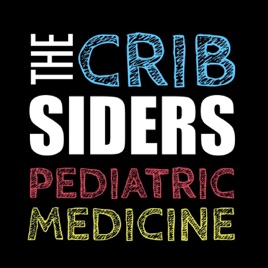
4.8
271
111
The Cribsiders
The Cribsiders
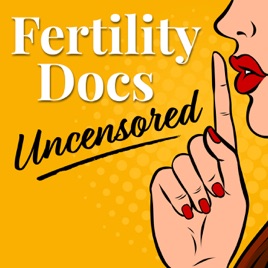
4.8
210
209
Fertility Docs Uncensored
Various

4.6
205
1072
The Egg Whisperer Show
Dr. Aimee Eyvazzadeh

4.8
2811
379
Weight Loss for Busy Physicians
Katrina Ubell
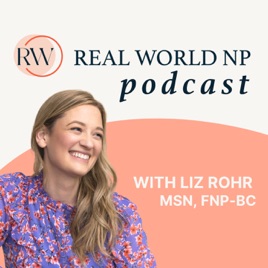
4.9
430
107
Real World NP
Liz Rohr
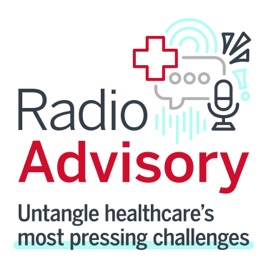
4.9
156
208
Radio Advisory
Advisory Board

4.3
171
420
The Jay Campbell Podcast
Jay Campbell

4.3
541
166
Psychology Unplugged
Dr. Corey J. Nigro

5
148
94
Febrile
Sara Dong

4.9
638
315
Real Life Pharmacology - Pharmacology Education for Health Care Professionals
Eric Christianson, PharmD; Pharmacology Expert and Clinical Pharmacist




